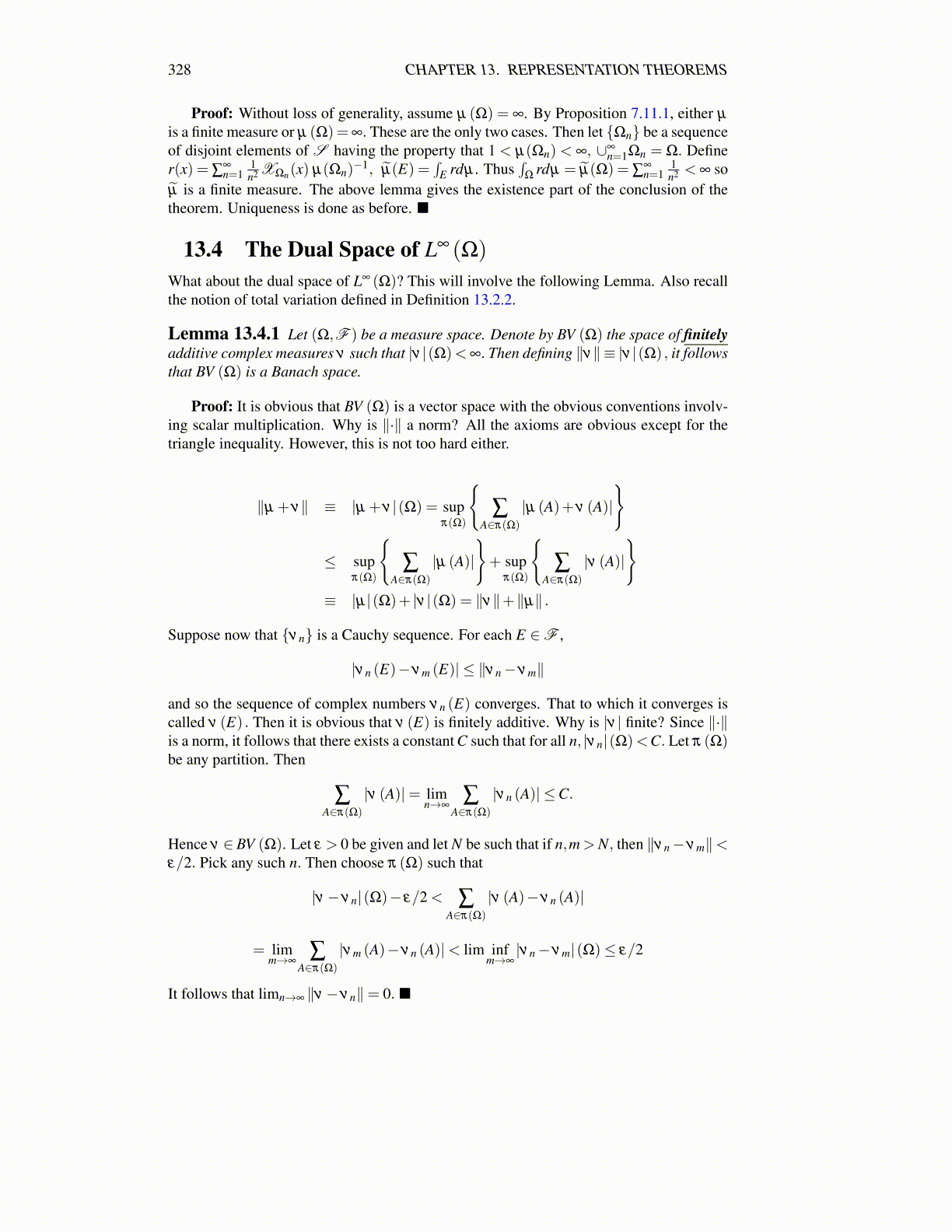
328 CHAPTER 13. REPRESENTATION THEOREMS
Proof: Without loss of generality, assume µ (Ω) = ∞. By Proposition 7.11.1, either µ
is a finite measure or µ (Ω) =∞. These are the only two cases. Then let {Ωn} be a sequenceof disjoint elements of S having the property that 1 < µ(Ωn) < ∞, ∪∞
n=1Ωn = Ω. Definer(x) = ∑
∞n=1
1n2 XΩn(x) µ(Ωn)
−1, µ̃(E) =∫
E rdµ . Thus∫
Ωrdµ = µ̃(Ω) = ∑
∞n=1
1n2 < ∞ so
µ̃ is a finite measure. The above lemma gives the existence part of the conclusion of thetheorem. Uniqueness is done as before. ■
13.4 The Dual Space of L∞ (Ω)
What about the dual space of L∞ (Ω)? This will involve the following Lemma. Also recallthe notion of total variation defined in Definition 13.2.2.
Lemma 13.4.1 Let (Ω,F ) be a measure space. Denote by BV (Ω) the space of finitelyadditive complex measures ν such that |ν |(Ω)<∞. Then defining ∥ν∥≡ |ν |(Ω) , it followsthat BV (Ω) is a Banach space.
Proof: It is obvious that BV (Ω) is a vector space with the obvious conventions involv-ing scalar multiplication. Why is ∥·∥ a norm? All the axioms are obvious except for thetriangle inequality. However, this is not too hard either.
∥µ +ν∥ ≡ |µ +ν |(Ω) = supπ(Ω)
{∑
A∈π(Ω)
|µ (A)+ν (A)|}
≤ supπ(Ω)
{∑
A∈π(Ω)
|µ (A)|}+ sup
π(Ω)
{∑
A∈π(Ω)
|ν (A)|}
≡ |µ|(Ω)+ |ν |(Ω) = ∥ν∥+∥µ∥ .
Suppose now that {νn} is a Cauchy sequence. For each E ∈F ,
|νn (E)−νm (E)| ≤ ∥νn−νm∥
and so the sequence of complex numbers νn (E) converges. That to which it converges iscalled ν (E) . Then it is obvious that ν (E) is finitely additive. Why is |ν | finite? Since ∥·∥is a norm, it follows that there exists a constant C such that for all n, |νn|(Ω)<C. Let π (Ω)be any partition. Then
∑A∈π(Ω)
|ν (A)|= limn→∞
∑A∈π(Ω)
|νn (A)| ≤C.
Hence ν ∈ BV (Ω). Let ε > 0 be given and let N be such that if n,m > N, then ∥νn−νm∥<ε/2. Pick any such n. Then choose π (Ω) such that
|ν−νn|(Ω)− ε/2 < ∑A∈π(Ω)
|ν (A)−νn (A)|
= limm→∞
∑A∈π(Ω)
|νm (A)−νn (A)|< lim infm→∞|νn−νm|(Ω)≤ ε/2
It follows that limn→∞ ∥ν−νn∥= 0. ■